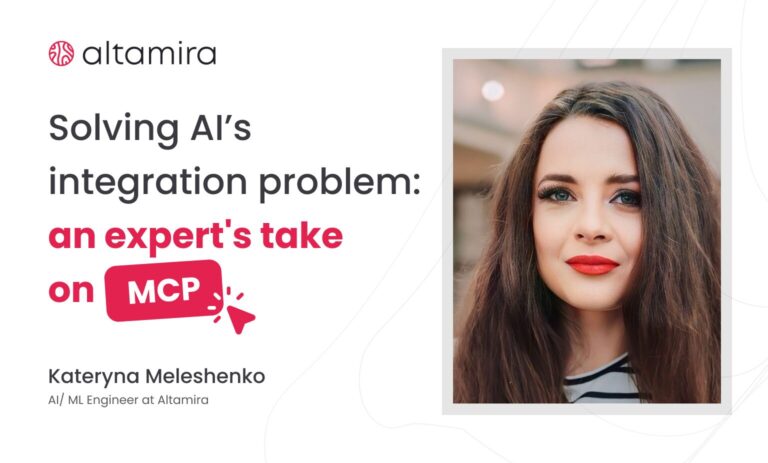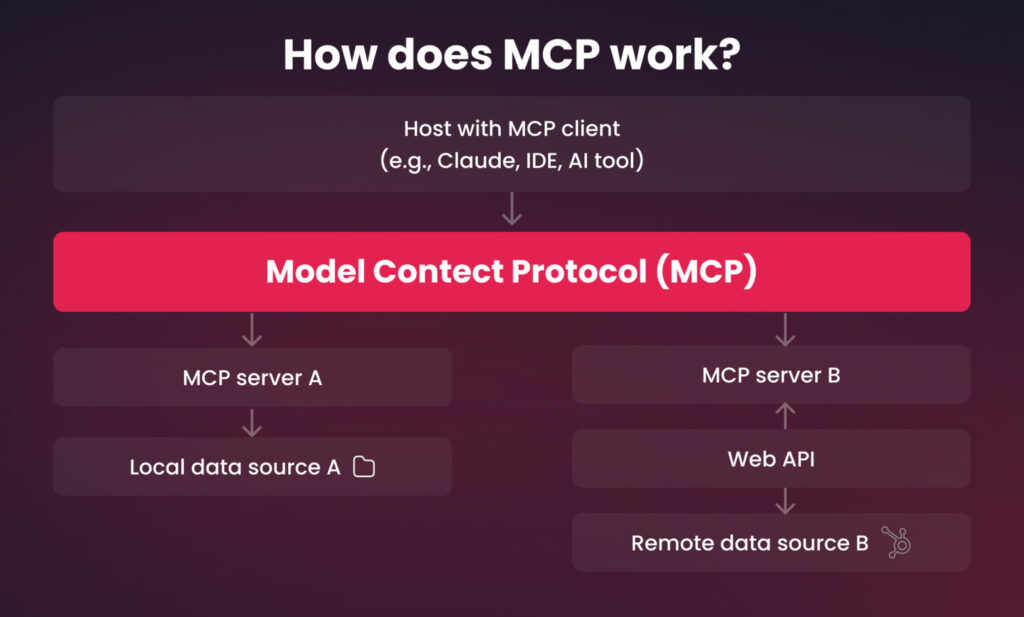AI models have come a long way in understanding language, generating code, and assisting with creative work – but ask them to pull data from a CRM or update a document based on live input, and things quickly fall apart.
As a rule, the root problem is its context. Most models operate in isolation, cut off from the systems and tools where real work happens.
The Model Context Protocol (MCP) addresses this gap. It gives AI a way to interact with the outside world – structured, consistent, and designed to scale.
Instead of building custom logic for every integration, now we can rely on a shared protocol that lets models retrieve information, trigger actions, and collaborate with existing software.
That’s why, our AI/ML Engineer, Kateryna Meleshenko, recently shared her insights to illuminate and explain how MCP is quietly reshaping AI development from the inside out – bridging the last mile between language models and the systems they need to work with.

What is MCP?
At its core, MCP is an open and simple communication protocol that standardises how applications provide context to large language models.
To put it simply, it tells AI models where to find information, how to use it, and how to interact with external tools.
Traditionally, connecting an AI model to a new app or data source meant writing custom integrations, one for each combination of model and system.
It was tedious and rarely scalable. MCP changes that by offering a shared “language” for interaction.
Whether the model is running on GPT-4, Claude, or an open-source LLM, it can use MCP to query a database, fetch a document, or even edit a graphic in real-time.
Think of how HTTP allows any browser to talk to any website using a shared set of rules.
MCP does the same for AI: it lets any AI model speak fluently with any compatible tool or service, and no special adapters are required.
How MCP works
Behind the scenes, MCP runs on a straightforward architecture made up of three parts.

MCP Server that acts as a gateway to tools, data sources, and services. It can run locally or in the cloud, allowing AI models to discover and use available resources. For example, an MCP server might expose access to a company’s CRM, inventory system, or design tools like Figma.
MCP Client that is embedded inside the AI application. The client relays requests from the model to the appropriate MCP server and returns the results. It acts as a translator between the model and the external world.
MCP Host is the actual application where the LLM runs (like Claude Desktop or an AI-powered integrated development environment IDE). The host integrates the MCP client, enabling the model to access external functionality through natural language.
So, imagine a product manager using an AI assistant embedded in their desktop app. The assistant wants to update a report with the latest sales numbers.
It sends a request (via the MCP client) to a server that connects to the company’s CRM.
The server fetches the data, returns it, and the model uses it to rewrite the report in seconds – all without any hard-coded integrations and stress along the way.
Why MCP matters
Historically, integrating AI with real-world tools has been a mess. Developers had to write and maintain custom code for each tool and model – an “N×M” problem where every new combination added more headaches. MCP turns that into an “N+M” problem.
Once that’s in place, everything speaks the same language, and new tools can be added or removed with minimal effort.

For enterprises
Build AI systems in a more consistent way
MCP gives companies a clear method for developing AI solutions across teams. It helps avoid duplicate work and makes it easier for teams to build on top of each other’s progress.
Establish clear roles across teams
MCP enables a clear separation of concerns between teams responsible for infrastructure and those building AI applications. As a result, each team can focus on their core expertise and proceed faster.
Develop faster
Since MCP offers a standard way to connect to tools and data, teams don’t need to create custom solutions for each integration. This speeds up development and reduces repetitive work.
Scale and maintain easier
Using a consistent approach across projects means systems are less likely to break when tools change. This makes AI infrastructure easier to manage and scale.
Use what you already have
Companies don’t need to rebuild everything from scratch. They can make existing tools and data sources accessible to AI apps by wrapping them with MCP servers.
Unlock new capabilities
By giving models real-time access to external systems, MCP moves AI beyond the limits of pretraining. Now, a model doesn’t need to “know everything” in advance.
It can dynamically query databases, trigger application actions, and respond to new situations on the fly. That means more useful, more adaptable AI in every industry – from marketing and design to logistics and healthcare.
For end users
Smarter AI that understands you
MCP helps build AI tools that better understand what you need and why. They can pull in the right data at the right time, which makes them more useful in real-world situations. As a result, users get access to “more powerful and context-rich AI applications.
Apps that know what’s going on
AI tools built with MCP can understand your context – what you’re doing, what you need, and what’s relevant – so they can respond more effectively.
Projects like Cursor and Windsurf show how AI can take meaningful actions based on real-world input.
Work with the tools you already use
MCP makes it easier for AI to connect with common platforms like GitHub or Asana. That means less switching between apps and a more consistent workflow.
Adapted to the way you work
AI built on MCP can be tailored to your needs. You can bring in your own data and connect your go-to tools, making the experience more personal and relevant.
Where MCP is being used
MCP is getting more popular across broad industry verticals and within leading SaaS platforms. In healthcare, it standardises communication between electronic health records, medical-imaging systems, and AI diagnostic models.
In finance, it synchronises real-time market data, risk-analysis engines, and regulatory-reporting pipelines.
In retail, it links inventory management, customer-analytics platforms, and personalised recommendation engines on the fly.
At the same time, platforms like Figma, Notion, and GitHub have adopted MCP to power context-aware AI features: Figma’s design assistant can query live design files; Notion’s AI automates workflows over custom databases; and GitHub’s AI helps developers with repository-specific code completions.
One standout example: developers have already used MCP to enable Claude to generate entire 3D scenes in Blender from a plain text prompt – a task that would normally require specialised scripts or plugins.
Why MCP matters for businesses
MCP isn’t just a technical breakthrough, it has direct implications for business performance and scalability.
Cut integration costs
It is clear without saying that custom integrations are quite expensive to build and maintain. Each new system added to your tech stack multiplies complexity, especially when trying to incorporate AI.
In turn, MCP reduces this overhead by offering a standardised connection layer.
Teams no longer need to rewrite the same logic for every use case. Once a tool supports MCP, it can connect to any compatible model or application, saving time, reducing risk, and accelerating deployment.
Move faster from idea to impact
With MCP, Proof of Concepts can evolve into production tools without a complete rebuild.
AI teams can prototype quickly, test across environments, and scale solutions with far less rework.
Whether you’re building internal tools or customer-facing products, MCP lets you focus on outcomes.
Build AI that fits into existing workflows
One of the biggest blockers to AI adoption is the gap between model capabilities and real-world systems. MCP closes that gap.
It allows AI to work directly with the platforms your teams already use – be it CRMs, ticketing systems, design tools, or internal databases – all without disrupting established workflows.
Stay model-agnostic and future-proof
The AI market is growing fast. However, what works today may not work tomorrow. MCP helps protect your investments by keeping integrations decoupled from specific vendors or model providers.
You can switch models or add new capabilities without needing to redo foundational work.
The final words
The Model Context Protocol marks a move away from piecemeal, one-off integrations toward a unified, open framework where AI assistants can reliably access and act on live data.
As more businesses adopt MCP, we can expect:
AI agents that easily pull and combine information from various systems,
API providers sharing ready-to-use MCP endpoints and documentation,
Standardised approaches to logging and security across AI interactions and far less manual integration work for developers.
Adopting MCP now puts you ahead – where context-aware AI becomes the norm, and your systems are always just one tool call away from intelligent automation.
How can we help you?
Whether you are looking to assess your business readiness for AI, add the latest AI tools, prototype your best idea or just upgrade your existing products, our approach is guaranteed to reduce your stress.
From project kick-off to software deployment, we guarantee quality and reliability, ensuring you never have to worry about the details.
Identify new opportunities with AI
As your zero headache software development partner, we will guide you through AI, share best practices, explore how it can benefit your business, and define what’s needed for implementation, ensuring you get the most out of new technology.
Get AI ready
We make AI simple and accessible by conducting complex research and deep technical evaluation first to select the best possible AI solution for your particular case.
Automate your processes
Automate your manual tasks and get full control over your operations to improve efficiency, accuracy, and scalability, so nothing keeps you up at night.
Transform your product with AI
Integrate AI into your product’s core functionality to deliver a smart and tailored user experience with real results in days, not weeks.
Push boundaries with Large Language Models
Analyse and extract meaningful insights from your data and get tailored recommendations to optimise your processes and reduce operational costs.
Contact us to learn more and get a free expert consultancy.






